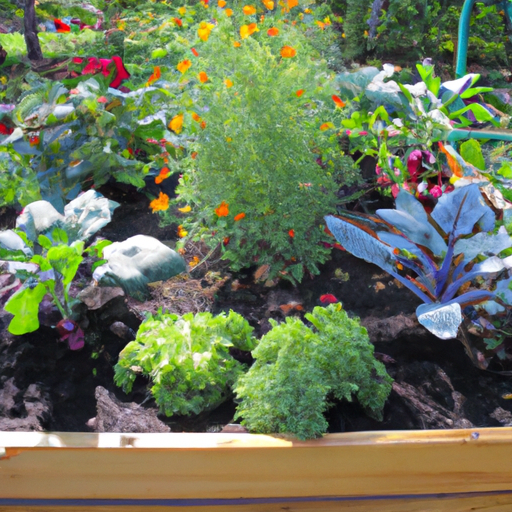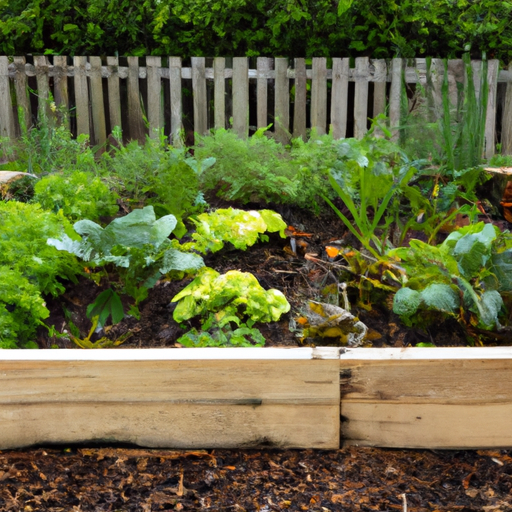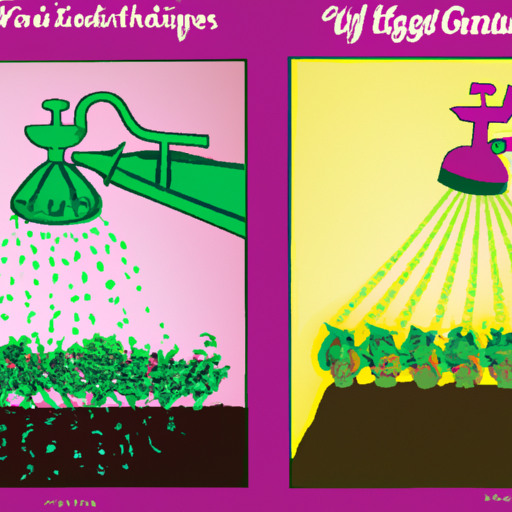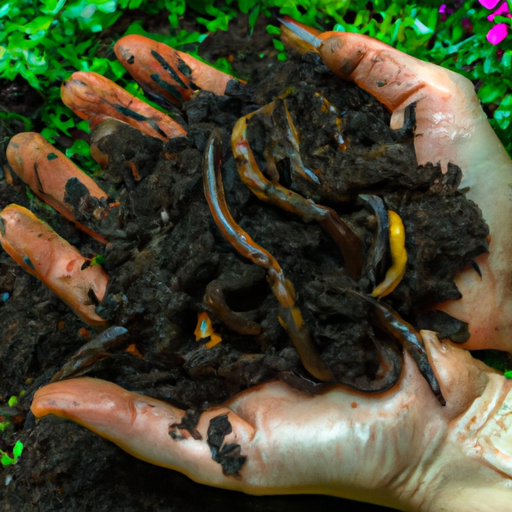Welcome to the world of raised bed gardening! As a Master Gardener, I have found that using companion planting is an excellent way to maximize space and plant growth in raised beds.
Companion planting involves pairing plants together that will benefit one another by providing mutual support or protection from pests, while also improving soil health.
One of the advantages of growing vegetables in raised beds is the ability to control the quality and fertility of the soil. By incorporating companion planting strategies into your garden design, you can enhance this control even further.
When done right, companion planting can help improve yield and reduce pest problems without relying on synthetic pesticides or fertilizers. So let’s dive deeper into how companion planting works and explore some tips for implementing it successfully in your own raised bed garden.
The Benefits Of Companion Planting In Raised Beds
Imagine a garden filled with rows of perfectly spaced plants, each one thriving and producing an abundance of fruits and vegetables.
Now imagine that same garden bursting with life as different plants grow together in harmony. This is the beauty of companion planting in raised beds.
As a Master Gardener, I can attest to the benefits of crop diversity and intercropping strategies. Companion planting allows for multiple crops to be grown in a small space while also promoting healthy soil, reducing pest problems, and increasing yields.
By pairing certain plants together, we can create natural pest control measures or provide additional nutrients to neighboring crops. The benefits are endless when it comes to companion planting in raised beds.
Understanding Plant Compatibility For Successful Pairings
Now that we’ve explored the benefits of companion planting in raised beds, let’s dive into understanding plant compatibility for successful pairings.
Knowing which plants complement each other can lead to healthier gardens with increased yields.
Crop rotation is an essential aspect of companion planting as it helps prevent soil-borne diseases and nutrient depletion by alternating crops from different families.
Intercropping involves growing two or more crop types together, creating a mutually beneficial relationship where they benefit each other’s growth and repel pests.
For example, intercropping tomatoes with basil not only enhances their flavor but also deters tomato hornworms.
Understanding plant compatibility will help you create a thriving garden while maximizing space and increasing plant growth.
Techniques For Maximizing Space In Your Raised Bed Garden
As a Master Gardener, I highly recommend using techniques for maximizing space in your raised bed garden.
Vertical gardening is an excellent way to grow more plants while using less ground space. Consider trellising vining vegetables such as tomatoes, cucumbers, and squash to increase yield per square foot.
You can also use interplanting strategies by mixing crops with different growth habits in the same bed. For example, plant low-growing herbs or greens under taller plants like peppers or eggplants. This not only maximizes space but also helps prevent soil erosion and provides natural pest control.
With these techniques, you’ll be amazed at how much you can grow in even the smallest of raised beds!
Enhancing Soil Health Through Companion Planting
As Master Gardeners, we know that enhancing soil health is key to maximizing plant growth and overall garden productivity. One effective way to achieve this is through companion planting. By strategically pairing plants with complementary growing habits and nutrient requirements, we can create a thriving ecosystem within our raised beds.
Not only does companion planting help control pests and diseases naturally, but it also improves soil structure and fertility over time.
To further boost your soil’s health, consider incorporating crop rotation and intercropping techniques into your gardening practices. Crop rotation involves alternating crops in different locations each year to prevent the buildup of pests and diseases specific to certain plants. Intercropping involves planting two or more crops together in the same bed, allowing them to share nutrients and space while deterring pests.
By implementing these methods alongside companion planting, you’ll be well on your way to creating a sustainable and productive garden for years to come.
Remember, healthy soil equals healthy plants, which ultimately leads to bountiful harvests!
Natural Pest Control With Companion Planting In Raised Beds
By enhancing soil health through companion planting, we have set the foundation for strong and healthy plants.
Now let’s talk about natural pest control with companion planting in raised beds.
One of the benefits of using this method is that it allows for crop rotation, which can help prevent pests from settling in one area.
Additionally, certain plants act as pollinator attractors, bringing beneficial insects into your garden to help control pests naturally.
Some examples include marigolds, sunflowers, and herbs such as dill and parsley.
By strategically placing these plants next to your fruits and vegetables, you can create a diverse ecosystem that encourages balance between predator and prey.
Remember to always research which companion plants work best for your specific crops and growing conditions before planning out your raised bed layout.
With careful consideration and planning, natural pest control through companion planting can be an effective way to keep your garden healthy without relying on harmful chemicals or pesticides.
Frequently Asked Questions
Can Companion Planting Be Used In Any Type Of Garden, Or Is It Only Effective In Raised Beds?
Did you know that companion planting can increase crop yields by up to 40%? That’s right! The benefits of companion planting are numerous and not limited to just raised beds.
It is a method that can be used in any type of garden, whether it be container gardening or traditional in-ground plots. By growing complementary plants together, they work symbiotically to deter pests, improve soil health, and maximize space utilization.
Whether you have a small urban balcony or acres of land for your garden, incorporating companion planting techniques can lead to healthier plants and higher yields. So don’t limit yourself – try out companion planting in any type of garden and see the results for yourself!
As a Master Gardener, I highly recommend experimenting with different combinations of plants to find what works best for your specific environment.
How Do You Determine Which Plants Are Compatible With Each Other For Companion Planting?
When it comes to companion planting, it’s crucial to know which plants are compatible with each other.
Companion planting benefits go beyond maximizing space and plant growth – they can also help deter pests and attract beneficial insects.
Factors affecting plant compatibility include nutrient needs, water requirements, and growth habits.
For example, planting tall sunflowers next to low-growing cucumbers may provide shade for the cucumber plants while allowing them to thrive in the same bed.
As a Master Gardener, I always recommend researching which combinations work best for your specific garden environment before implementing companion planting techniques.
Are There Any Negative Effects Of Companion Planting In Raised Beds, Such As Overcrowding Or Competition For Resources?
Competition concerns and plant spacing considerations are two important factors to keep in mind when practicing companion planting in raised beds.
While there can be many benefits to growing plants together, it’s crucial to make sure they have enough space and resources to thrive.
Overcrowding can lead to stunted growth or disease, while competition for nutrients and sunlight can leave some plants struggling.
To avoid these issues, it’s essential to research each plant’s needs before pairing them up and plan out your garden bed accordingly.
By carefully selecting compatible companions and providing adequate spacing, you’ll be able to maximize the productivity of your raised bed without sacrificing plant health.
Can Companion Planting Be Used To Attract Certain Beneficial Insects, Such As Bees Or Ladybugs?
Companion planting is a popular gardening technique that involves growing different plants together to benefit each other.
One of the benefits of this practice is attracting certain beneficial insects like bees and ladybugs, which can help in pollination and pest control respectively.
Pollinator-friendly companion planting includes pairing flowers with vegetable crops such as tomatoes, peppers or cucumbers. For example, marigolds are known for their ability to attract bees while repelling harmful nematodes from attacking plants’ roots.
Another example is interplanting basil and tomato since they complement each other’s growth requirements while discouraging pests like aphids and hornworms.
By using companion planting techniques, gardeners can maximize space usage, promote plant growth and create an environment that supports biodiversity in their gardens.
How Long Does It Take To See The Benefits Of Companion Planting In Raised Beds, And How Long Will The Effects Last?
When it comes to the benefits of intercropping, one must consider both short-term and long-term effects.
Succession planting techniques allow for a continuous cycle of growth and harvest, providing ongoing advantages for companion plants in raised beds.
It may take some time to see the full scope of these benefits, but like a seed planted deep in rich soil, the rewards will eventually sprout forth.
The length of time that these effects last can vary depending on factors such as climate, plant selection, and pest management practices.
As a Master Gardener, I recommend approaching companion planting with patience and attention to detail to fully reap its many rewards.
Conclusion
In conclusion, companion planting in raised beds is an effective way to maximize space and plant growth. This method can be used in any type of garden, but raised beds are particularly suited for this technique due to their contained environment.
Determining which plants are compatible with each other can be done through research or trial and error. However, it’s important to note that overcrowding or competition for resources may occur if not planned properly.
Companion planting can also attract beneficial insects like bees or ladybugs, further improving the overall health of your garden. As Master Gardeners say: ‘Companion planting is like having good neighbors; they help each other grow.’
The benefits of companion planting will become noticeable over time and last throughout the growing season. So, why not give it a try in your own raised bed garden? You might just find yourself with a thriving ecosystem full of happy, healthy plants!






